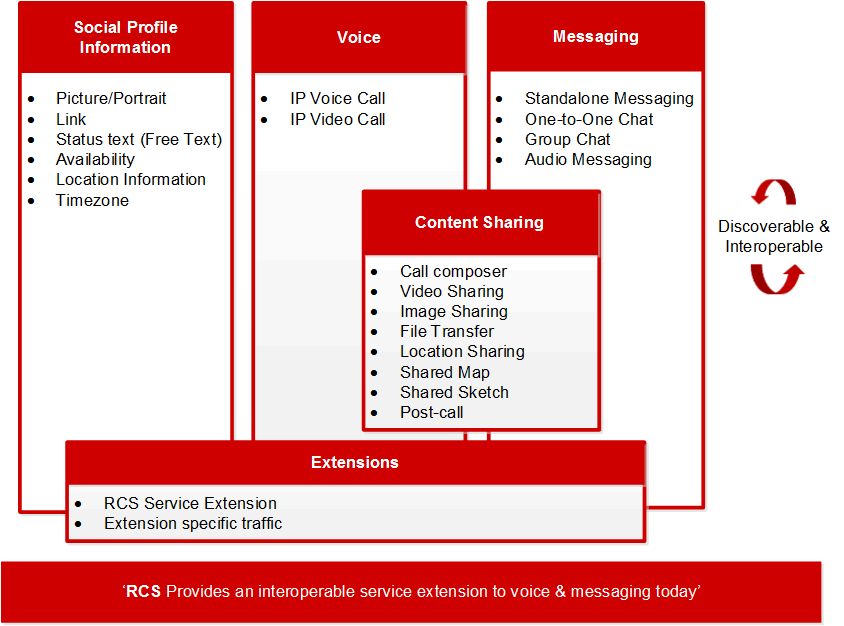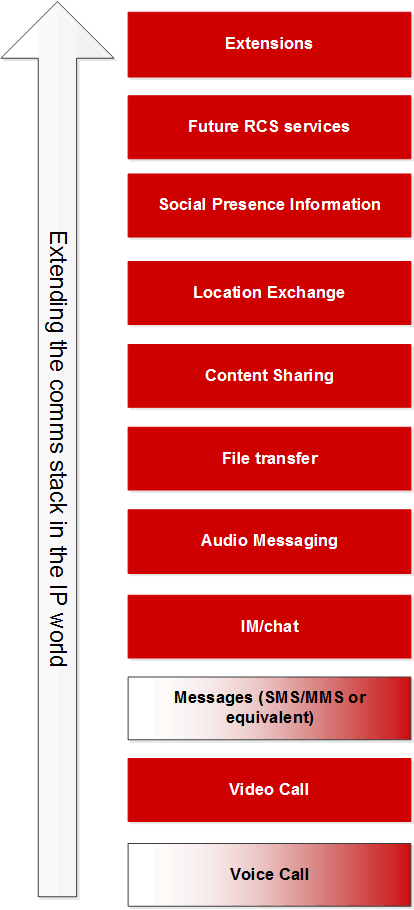1.1 RCS Principles and Vision / RCS原则和愿景
RCS (Rich Communication Suite) provides a framework for discoverable and interoperable advanced communication services and detailed specifications for a basic set of advanced communication services.
RCS(富通信套件)为可发现和可互操作的高级通信服务和一组基本的高级通信服务的详细规范提供了一个框架。
Figure 1 presents the set of services specified in RCS. All these services can be deployed using a variety of clients on access networks that can be Service Provider controlled or not.
图1给出了RCS中指定的服务集合。 所有这些服务可以使用接入网络上的各种客户端来部署,这些接入网络可以是服务提供商控制与否。

Figure 1: RCS Positioning / 图1:RCS定位
As a headline, RCS provides an “interoperable extension to voice and messaging today”. The services are designed to run over data networks and can stand alone (e.g. share a picture from the media gallery) or be used in combination with a voice call (e.g. see-what-I-see video).
作为标题,RCS提供了一个“当今语音和消息的互操作的扩展”。 服务被设计为在数据网络上运行并且可以独立(例如,从媒体库共享图片)或者与语音呼叫(例如,see-what-I-see视频)结合使用。

Figure 2: RCS Industry Proposition / 图2:RCS行业主张
As indicated in section 1.2.2, a Service Provider may choose not to deploy all services defined as part of RCS; however when deploying an individual RCS service it will be interoperable with other Service Providers deploying the same service. This also means that even if this specification offers different deployment options to accommodate for different market realities, full interoperability between those deployments is provided for each corresponding service and for the RCS discovery framework.
如第1.2.2节所示,服务提供商可以选择不部署定义为RCS的一部分的所有服务; 但是当部署单个RCS服务时,它将与部署相同服务的其他服务提供商互操作。 这也意味着即使该规范提供了不同的部署选项以适应不同的市场现实,也为每个相应的服务和RCS发现框架提供这些部署之间的完全互操作性。
The cornerstone mechanism that enables RCS is a service or capability discovery framework. For example, when a user scrolls through their address book, they will see their contacts with the RCS services that are available to communicate.
启用RCS的基石机制是服务或功能发现框架。 例如,当用户滚动通过他们的地址簿时,他们将看到他们与可用于通信的RCS服务的联系人。
This mechanism is implemented either using the Session Initiation Protocol’s (SIP) OPTIONS request or using a Presence-based solution defined in RCS Release 1-4. Both will result in one of three types of response:
使用会话发起协议(SIP)OPTIONS请求或使用RCS版本1-4中定义的基于现场的解决方案来实现此机制。 两者都将导致三种类型的响应之一:
The contact is registered for service resulting in the contact’s current service capabilities being received and logged.
联系人注册服务,导致联系人当前的服务功能被接收和记录。The contact is not registered (they are provisioned but not registered).
联系人未注册(已设置但未注册)。The contact is not found (they are not provisioned for service).
找不到联系人(它们未设置为服务)。
This discovery mechanism is important since it ensures User A can determine what services are available before communicating and allows Service Providers to roll-out new agreed services based on their own deployment schedule or market requirements. These same mechanisms can be used to initially discover (and/or periodically check) the service capabilities of all the contacts within an address book when the user first registers for the service.
这种发现机制是重要的,因为它确保用户A可以在通信之前确定什么服务可用,并且允许服务提供商基于它们自己的部署时间表或市场要求推出新的同意的服务。 当用户首次注册服务时,这些相同的机制可以用于最初发现(和/或周期性地检查)地址簿内的所有联系人的服务能力。